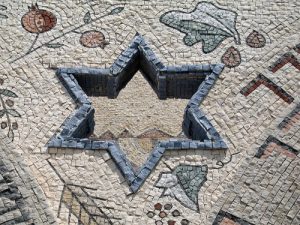Israeli Culture History
Israeli culture is a fusion of different subcultures due to the presence of immigrants from five continents and more than one hundred countries such as Europe, North Africa and Asia, in this way there is the coexistence of Mizrahim, Arabs, Russian Jews, Ethiopian Jews and Ultra Orthodox Jews, as a results of Jewish aliyah starting from the 19th century. In the 20th century Hebrew language schools named ulpanim grew up in all the country in order to help the new immigrants, Olim Chodashim, to learn the Hebrew language with a fast learning method.
Israeli Literature
 Two important figures of the Israeli literature were a Russian and an European immigrants who gave life to the modern Hebrew literature, Yosef Brenner and Shmuel Agnon. Yosef Haim Brenner was born in a poor Jewish family in the Russian Empire and since his childhood he was publishing his stories using a mixture of Hebrew, Aramaic, Yiddish, English and Arabic. Shmuel Yosef Agnon, who became a Nobel Prize literature writer and known with the acronym Shai Agnon, was born in the Polish Galicia, now Ukraine, and since he was a child he published his poems and stories in Hebrew and Yiddish. During the period that goes from the 1940s until the 1950s the main writers are S. Yizhar, Moshe Shamir, Hanoch Bartov and Benjamin Tammuz. Starting from the 1960s A.B. Yehoshua, Amoz Oz and Yaakov Shabtai are the protagonist of the Israeli literature that is translated in many languages.
Two important figures of the Israeli literature were a Russian and an European immigrants who gave life to the modern Hebrew literature, Yosef Brenner and Shmuel Agnon. Yosef Haim Brenner was born in a poor Jewish family in the Russian Empire and since his childhood he was publishing his stories using a mixture of Hebrew, Aramaic, Yiddish, English and Arabic. Shmuel Yosef Agnon, who became a Nobel Prize literature writer and known with the acronym Shai Agnon, was born in the Polish Galicia, now Ukraine, and since he was a child he published his poems and stories in Hebrew and Yiddish. During the period that goes from the 1940s until the 1950s the main writers are S. Yizhar, Moshe Shamir, Hanoch Bartov and Benjamin Tammuz. Starting from the 1960s A.B. Yehoshua, Amoz Oz and Yaakov Shabtai are the protagonist of the Israeli literature that is translated in many languages.
Israeli Visual Art
In 1906 the Bezalel Academy of Fine Art arose as one of the Israel’s oldest and most prominent art institution. It was founded by Jewish Lithuanian artist Boris Schatz who brought the traditional European styles in Israel such as the Art Noveau and the decorative style of the 1890s. As form of modern architecture the German Bauhaus school of architecture and design started to flourish in the Israel of 1930th, with its characteristic sleek and geometric shapes, following the large immigration of Jews from Germany and Poland due to the rise of the Nazi party. The 1940s were represented by The Cnaanite Movement and Ofakim Hadashim, passing to the “The Want of Matter” Movement in the 1960s, the Israeli Conceptual Art in the 1970s, the Political Art in the 1980s and the Israeli Contemporary Art in the 1990s.


Israeli Music
Israel is the house of many classical music ensembles like the Israel Philarmonic and the New Israeli Opera. The Israel Philarmonic Orchestra began in 1936 and in the 1980 the New Israeli Opera. The contemporary music in Israel there is a fusion of Ethiopian, Middle-Eastern soul, rock, jazz, hip-hop, electronic, Arabic and pop music. With a strong influence of the music from Diaspora and modern music such as Hassidic songs, Asian pop, Arab folk, Israeli hip hop and heavy metal.
Israeli Dance
In the dance area in Israel there are traditional folk dances like the Hora and Yemenite dances. In the modern dance different dance companies are very important like the Batsheva Dance Company and the Kibbutz Contemporary Dance Company. Usually there is an annual dance festival in Karmiel every July with more than 5000 dancers.
Israeli Museums
Israel has more than 200 museums, being in this way the country with the highest number of museums per capita in the world. Among them, the Jerusalem’s Israel Museum has a special section showing the Dead Sea Scrolls and one of the largest collection of Jewish religious art, Israeli art, sculptures and precious paintings.

Israeli Theater and Cinema
The first Hebrew theatre, the Habimah, at the beginning founded in Moscow in 1917, moved to Israel in Tel Aviv in 1931. Another main theater is the Ohel Theater, founded in 1925, the Cameri Theatre, Beit Lessin Theater, Gesher Theater, Haifa Theatre and Beersheba Theater. And regarding the cinema, in the 1950, the first productions were “Hill 24 Doesn’t Answer” and “They Were Ten”, later the filmography was centered around theme regarding the Holocaust survivors and the new immigrants, the Israeli-Arab conflict and military service. For three years sequentially, the Israeli films “Beaufort” (2008), “Waltz with Bashir” (2009) and “Ajami” (2010) have been nominated at the Academy Awards. The largest repository of film material on Jewish themes in the world is the Spielberg Film Archive at the Hebrew University of Jerusalem.
More Informations about Israel
Even the Israeli fashion design emerges in the international scenario with Israeli designers such as the swimwear company Gottex. Besides archeology, arts, literature and music, Israel due to the presence of national parks and nature reserves, registering almost 6.5 million visits every year. And additionally Israeli Mediterranean coast extends for 190 kilometers, with several beaches for bathing, surfing and other sports. And from a country of 640,000 Jews in 1948, when Israel became an Independent State, today this young country counts more than 8 millions of inhabitants with its unique culture due to the diversity of its population.

